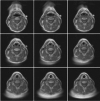Automated segmentation of the larynx on computed tomography images: a review
- PMID: 35529346
- PMCID: PMC9046475
- DOI: 10.1007/s13534-022-00221-3
Automated segmentation of the larynx on computed tomography images: a review
Abstract
The larynx, or the voice-box, is a common site of occurrence of Head and Neck cancers. Yet, automated segmentation of the larynx has been receiving very little attention. Segmentation of organs is an essential step in cancer treatment-planning. Computed Tomography scans are routinely used to assess the extent of tumor spread in the Head and Neck as they are fast to acquire and tolerant to some movement. This paper reviews various automated detection and segmentation methods used for the larynx on Computed Tomography images. Image registration and deep learning approaches to segmenting the laryngeal anatomy are compared, highlighting their strengths and shortcomings. A list of available annotated laryngeal computed tomography datasets is compiled for encouraging further research. Commercial software currently available for larynx contouring are briefed in our work. We conclude that the lack of standardisation on larynx boundaries and the complexity of the relatively small structure makes automated segmentation of the larynx on computed tomography images a challenge. Reliable computer aided intervention in the contouring and segmentation process will help clinicians easily verify their findings and look for oversight in diagnosis. This review is useful for research that works with artificial intelligence in Head and Neck cancer, specifically that deals with the segmentation of laryngeal anatomy.
Supplementary information: The online version contains supplementary material available at 10.1007/s13534-022-00221-3.
Keywords: Artificial Intelligence; Computed Tomography; Computer-Aided Detection; Larynx Segmentation; Medical Image Processing.
© The Author(s) 2022.
Conflict of interest statement
Conflict of interestDivya Rao declares that she has no conflict of interest. Dr Prakashini K declares that she has no conflict of interest. Dr Rohit Singh declares that he has no conflict of interest. Vijayananda J declares that he has no conflict of interest.
Figures






Similar articles
-
AnatomyNet: Deep learning for fast and fully automated whole-volume segmentation of head and neck anatomy.Med Phys. 2019 Feb;46(2):576-589. doi: 10.1002/mp.13300. Epub 2018 Dec 17. Med Phys. 2019. PMID: 30480818
-
Shape constrained fully convolutional DenseNet with adversarial training for multiorgan segmentation on head and neck CT and low-field MR images.Med Phys. 2019 Jun;46(6):2669-2682. doi: 10.1002/mp.13553. Epub 2019 May 6. Med Phys. 2019. PMID: 31002188 Free PMC article.
-
Segmentation of organs-at-risks in head and neck CT images using convolutional neural networks.Med Phys. 2017 Feb;44(2):547-557. doi: 10.1002/mp.12045. Med Phys. 2017. PMID: 28205307 Free PMC article.
-
A review on AI-based medical image computing in head and neck surgery.Phys Med Biol. 2022 Aug 18;67(17). doi: 10.1088/1361-6560/ac840f. Phys Med Biol. 2022. PMID: 35878613 Review.
-
Automatic Segmentation of Multiple Organs on 3D CT Images by Using Deep Learning Approaches.Adv Exp Med Biol. 2020;1213:135-147. doi: 10.1007/978-3-030-33128-3_9. Adv Exp Med Biol. 2020. PMID: 32030668 Review.
Cited by
-
Strategies for mitigating inter-crystal scattering effects in positron emission tomography: a comprehensive review.Biomed Eng Lett. 2024 Sep 17;14(6):1243-1258. doi: 10.1007/s13534-024-00427-7. eCollection 2024 Nov. Biomed Eng Lett. 2024. PMID: 39465104 Free PMC article. Review.
-
Accurate Automated Quantification of Dopamine Transporter PET Without MRI Using Deep Learning-based Spatial Normalization.Nucl Med Mol Imaging. 2024 Oct;58(6):354-363. doi: 10.1007/s13139-024-00869-y. Epub 2024 Jul 22. Nucl Med Mol Imaging. 2024. PMID: 39308485
-
Computer-Aided Diagnosis of Laryngeal Cancer Based on Deep Learning with Laryngoscopic Images.Diagnostics (Basel). 2023 Dec 14;13(24):3669. doi: 10.3390/diagnostics13243669. Diagnostics (Basel). 2023. PMID: 38132254 Free PMC article.
-
Deep Learning-Based Segmentation of Head and Neck Organs-at-Risk with Clinical Partially Labeled Data.Entropy (Basel). 2022 Nov 15;24(11):1661. doi: 10.3390/e24111661. Entropy (Basel). 2022. PMID: 36421515 Free PMC article.
-
Exploring Radiomics for Classification of Supraglottic Tumors: A Pilot Study in a Tertiary Care Center.Indian J Otolaryngol Head Neck Surg. 2023 Jun;75(2):433-439. doi: 10.1007/s12070-022-03239-2. Epub 2022 Nov 24. Indian J Otolaryngol Head Neck Surg. 2023. PMID: 37275092 Free PMC article.
References
-
- Muscat JE, Wynder EL. Tobacco, alcohol, asbestos, and occupational risk factors for laryngeal cancer. Cancer 69 (1992). 10.1002/1097-0142(19920501)69:9h2244:: AID-CNCR2820690906i3.0.CO;2-O. - PubMed
-
- Anon: Larynx Gco.iarc.fr (2020). https://gco.iarc.fr/today/data/factsheets/cancers/14-Larynx-fact-sheet.pdf Accessed 2021-10-08.
-
- Siegel RL, Miller KD, Fuchs HE, Jemal A. Cancer statistics, 2021. CA: A Cancer J Clin 71 (2021). 10.3322/caac.21654. - PubMed
-
- Anon: L. 2021. Larynx Concise Medical Knowledge. https://wwwlecturio.com/concepts/larynx/.
Publication types
LinkOut - more resources
Full Text Sources
